NOVEMBER 1933
Scroll down to read
Five November 1933 posts

Nov. 1, 1933
“A Loooong Itinerary”
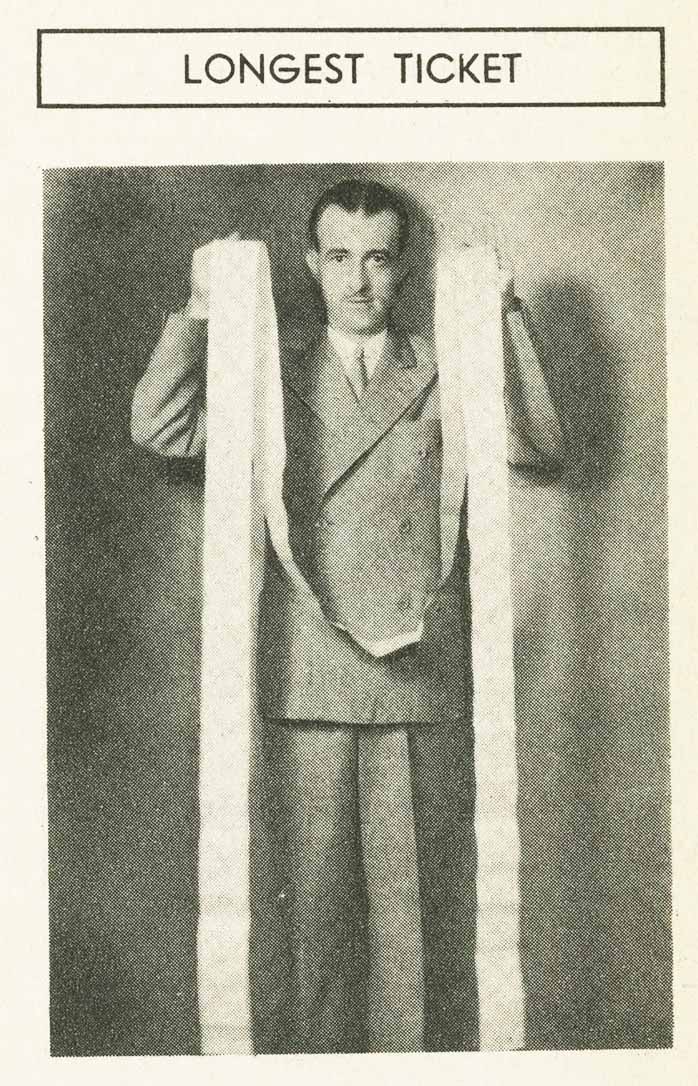 Photo : “Longest Ticket.” Pan American Air Ways, Vol. 4, No. 5 (Oct. 1933), p. 7.
Photo : “Longest Ticket.” Pan American Air Ways, Vol. 4, No. 5 (Oct. 1933), p. 7.
University of Miami Special Collections, Pan American World Airways, Inc. records.
From page seven, Pan America Air Ways, October 1933:
“We haven’t found any reliable statistics to the contrary yet, so we hereby present this as a picture of the world’s longest transportation ticket. It was sold to Mr. O.B. Small of the Texas Oil Company, by Charles A. Boillod, head of the New York City traffic office and entitles the bearer to travel over Pan American airlines from Brownsville to Cristobal, Kingston, Havana, Guantanamo, Santiago, San Juan, Port of Spain, Maracaibo, Kingston, Havana and Miami with 48 stopovers. Photograph shows M.H. Delanney, of the New York City traffic office, holding the ticket which measures 14 feet 9 and one-half inches.”
While a 48-stop, trans-Caribbean schedule may read like fiction, social media stunt, or punishment awaiting sinners in a recast of Dante’s The Inferno, that 1933 itinerary was plausible.
Assuming Mr. Small left Pan Am’s Brownsville, Texas base on the Sunday morning flight to Mexico City and took every next flight available down the line, he could complete the figure-eight course in fourteen days: down the spine of Central America, looping back to Havana via Jamaica, crossing the length of Cuba before arching south through the Antilles and coming west across South America’s north coast to Barranquilla, Colombia, from which he would turn north again through Kingston, Jamaica, to Miami.
At a more-leisurely pace, his route, as described, kept Mr. Small in transit for four weeks or more given existing route schedules.
Fastest route or not, Mr. Small’s 7,000-mile junket introduced him to at least four Pan Am workhorse aircraft: Ford AT-E Tri-motor, Consolidated Commodore, Sikorsky S-38, and the new Sikorsky S-40. After spending all but the last 1,200 miles in loud Ford, Consolidated, and S-38 planes, the sound of 9-cylinder Pratt & Whitney engines echoed in his ears long after he returned to his office in New York City’s Chrysler Building.
Sources:
“Pan American Air Ways System: Timetables & Tariffs” (May 1934). University of Miami Special Collections, Pan American World Airways, Inc. records. https://digitalcollections.library.miami.edu/digital/collection/asm0341/id/20765/rec/42
“Longest Ticket.” Pan American Air Ways, Vol. 4, No. 5 (Oct. 1933), p. 7. University of Miami Special Collections, Pan American World Airways, Inc. records https://digitalcollections.library.miami.edu/digital/collection/asm0341/id/41149/rec/5

Nov. 7, 1933
“A Hot Tropical Season”
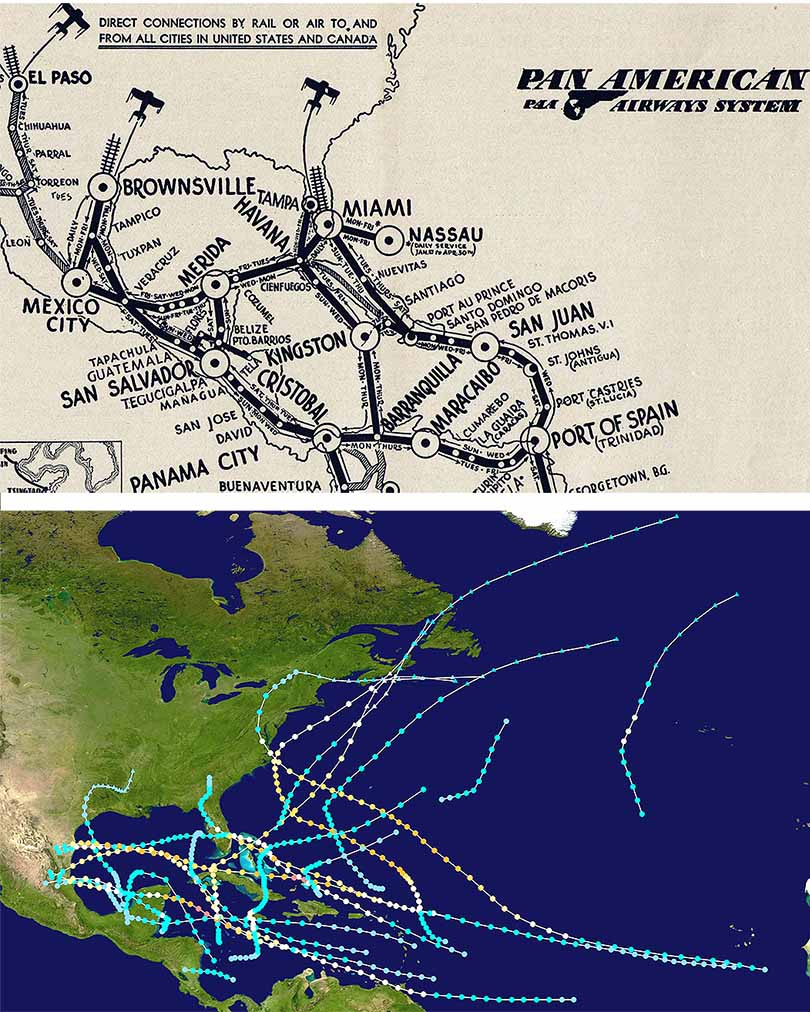
Photo compilation: “Time tables, tariffs: Havana, Nassau, Mexico, Panama, West Indies, Central and South America,” May 1, 1934, p. 4. (Pan Am Route Map cropped to display Central American and Caribbean routes). https://digitalcollections.library.miami.edu/digital/collection/asm0341/id/20765/rec/42. “Season Summary Map,” Wikimedia Commons https://en.wikipedia.org/wiki/1933_Atlantic_hurricane_season
By November 1933, Pan American Airways’ meteorologists in Miami and Brownsville were exhausted. Using rudimentary tools -- primarily barometer and wind reports from ships, ground stations and pilots -- they had sniffed-out, tracked, and forecast storms throughout Pan Am’s Western Atlantic and Caribbean flight lanes.
Thirteen of the season’s twenty tropical storms had affected operations:
No.1 (May 14 – 19):
Formed off Belize, the tropical storm traveled north, hooked around the Yucatan, and hit Ciudad del Carmen, Mexico.
No. 2 (June 24 – July 7):
Danced 3,000 miles east-to-west as a Category 2 hurricane traversing the Lesser Antilles, Venezuela’s coast, Jamaica, the Cayman Islands, Cuba, the Yucatan before its south Texas final landfall.
No. 3 (July 14 – 24):
Followed a similar path one week later as a slow-moving storm to drench the Yucatan and south Texas.
No. 5 (July 24 – Aug 5):
Became a Category 1 hurricane off Puerto Rico before hitting the Bahamas, south central Florida, crossing the Gulf of Mexico to hit south of Brownsville, Texas.
No. 7 (Aug 14 – 21):
Formed near Trinidad, passed south of Jamaica, hooked around Cuba’s west end to hit near Tampa, Florida.
No. 8 (Aug 22 – Sept. 5):
Formed west of Africa, crossed the Atlantic and Gulf of Mexico on a west-northwest line that could have been drawn with a ruler. This hurricane hit Cuba Sept. 1, with 120 m.p.h. winds, then intensified to 125 m.p.h. before hitting Brownsville, Texas.
No. 10 (Aug. 26 – 29):
Located in the Bay of Campeche, was more nuisance than route disrupter.
No. 11 (Aug. 31 – Sept. 4):
A Category 4 hurricane tracked just north of #8 hitting the Bahamas with 125 m.p.h. before tracking due north through Florida.
No. 13 (Sept. 12 – 15):
Formed east of Guatemala, crossed the Yucatan, grew to a Category 2 hurricane (110 m.p.h. winds) and pounded Tampico, Mexico.
No. 14 (Sept. 16 – 25):
The season’s second mega storm formed above Guiana, intensified to Category 5 as it traversed the central Caribbean, hit Cozumel, Mexico, Sept. 22 as a Category 4 and Tampico with 110 m.p.h. winds and torrential rain.
No. 17 (Oct. 1 – 6):
Started off Nicaragua and oozed north hinting it might hit Miami from the southwest as it crossed western Cuba as a Category 2 storm; instead, it intensified in the Florida Straights to Category 3, and hit the Bahamas at 125 m.p.h.
No. 18 (Oct. 25 – Nov. 7):
Hit Jamaica as a Category 1 hurricane, crossed Cuba before turning northeast to drench the Bahamas.
No. 20 (Nov. 15-17):
Hit Nicaragua with a 60 m.p.h.-winds whimper.
The 1933 hurricane season’s twenty storms were not eclipsed for seventy-two years, and it remains the fourth most-active season to date.
Source:
“1933 Atlantic Hurricane Season.” Wikipedia. en.wikipedia.org. Accessed Oct. 2, 2024.
Nov. 15, 1933
“Flying the Coup”
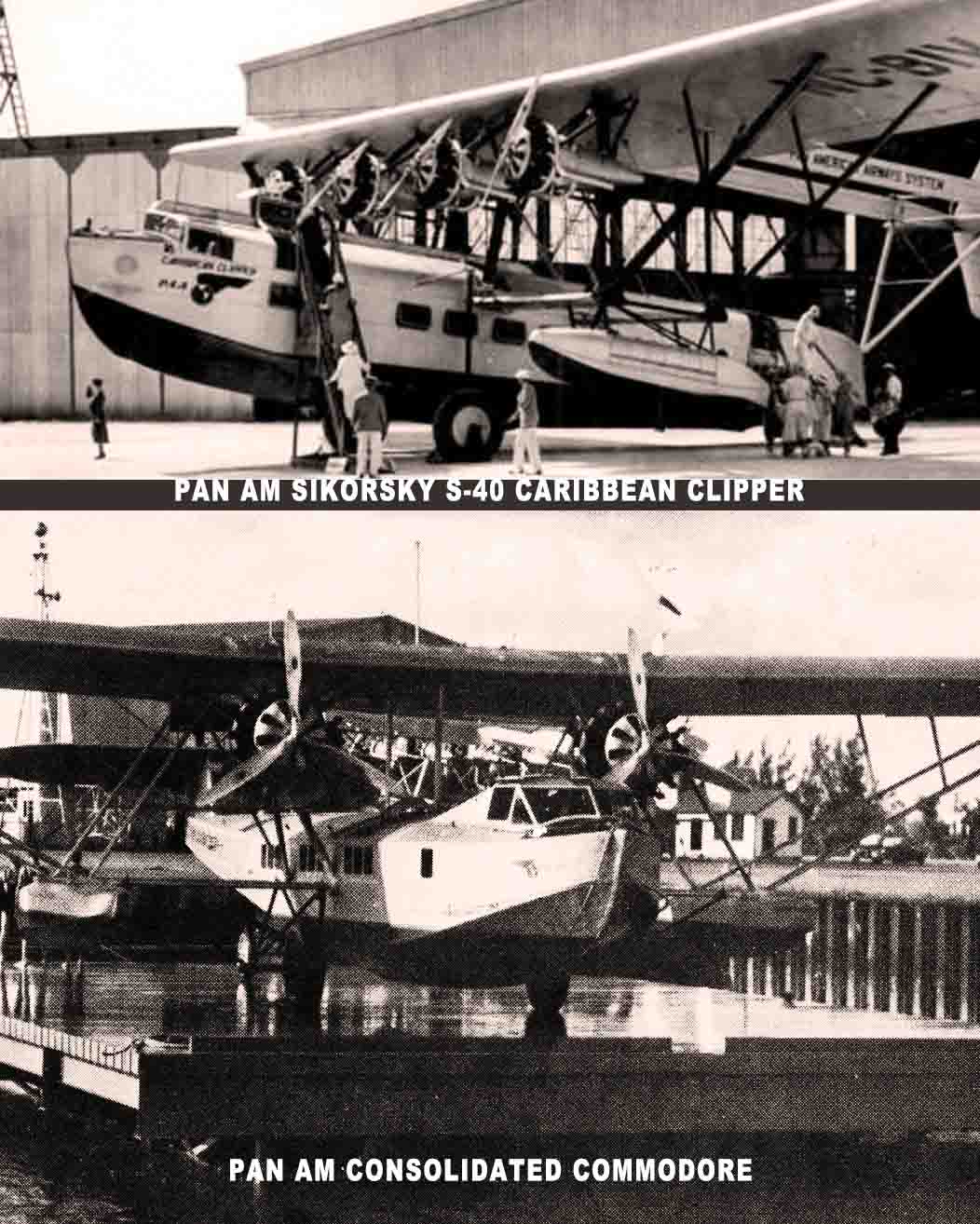
Photo Compilation of PAA Flying Boats: (Top) Pan Am Sikorsky S-40 Caribbean Clipper, State Archives and Library of Florida, Florida Memory, https://www.floridamemory.com/items/show/36899#! (Bottom) A Docked Pan Am Consolidated Commodore (PAHF Collection).
Charles Lorber, who liked consistency, faced inconsistency for a second trip.
A hurricane crossing Cuba was the fly-in-the-ointment ten days earlier, Sunday morning, October 29, when, choosing safety over schedule, he backtracked to Dinner Key halfway into the Caribbean Clipper’s (Sikorsky S-40, NC81V) two-hour-fifteen-minute Miami-Havana flight. Havana’s weather was so bad the next day (Monday October 30) that he diverted 350 miles east of Havana to Nuevitas, Cuba, unloaded Havana-bound passengers, mail and airfreight, refueled and continued to Kingston, Jamaica.
A week later (Wednesday, November 8), rather than visiting Havana and Cienfuegos before Kingston, Captain Lorber was flying Consolidated Commodore 660M directly to Kingston with its fuel tanks filled to the brim, thankful that of Pan Am’s 14 Commodores 660M’s range was the greatest.
Today’s storm was political: Cuba, a-roil since a September coup d’état ousted President Gerardo Machado -- the “Sargent’s Revolt” -- now faced a counter-coup d’état attempt which started Monday, November 6 in Havana and spread to other cities. Camaguey, a mid-island base for Pan Am subsidiary’s Compañia Nacional Cubana de Aviación, S.A., experienced 24 bomb explosions over the weekend.
Pan Am halted Cuba passenger service on Wednesday the 8th, explaining that such service “must depend upon absolute safety from firing by armed forces,” which, around Havana, included machine guns with tracer bullets and anti-aircraft cannons. *
When Lorber landed in Cristobal, Panama, Thursday evening, November 9, Cuba was no more settled. His colleague Wallace “Wally” Culbertson brought Consolidated Commodore NC670M north from Panama using Cienfuegos, Cuba as his only post-Kingston stop, as did Ralph Dahlstrom on Sunday the 12th and Roy Keeler on Wednesday the 15th.
By Friday the 17th Havana’s political storm had ebbed enough that Pan Am asked Captain Lorber to fly the normal Canal Zone to Miami route and he stopped at Cienfuegos and Havana before getting home to Miami that evening with a story to tell Anna, and their children.
* Crews flying the twice-a-day Miami-Havana route were expected to keep the mail route open regardless of live-fire risks.
• “Air Line Service Still Disrupted.” The Miami Herald (Fri., 10 Nov., 1933), p. 3.
•“Firm Action Ordered by Colonel Batista.” The Miami Herald (Tues., 7 Nov., 1933), p. 8.
•“Pan American Planes Resume Cuban Service.” The Miami Herald (Sun., 12 Nov., 1933), p. 3.
•“Planes May Resume Flights to Havana.” The Miami Herald (Thurs., 9 Nov., 1933), p. 4.
•“PAA Through Kingston 1930-1934.” Author’s database.
Nov. 21, 1933
“ ‘The Flying Mayor’ Takes a Clipper Home”
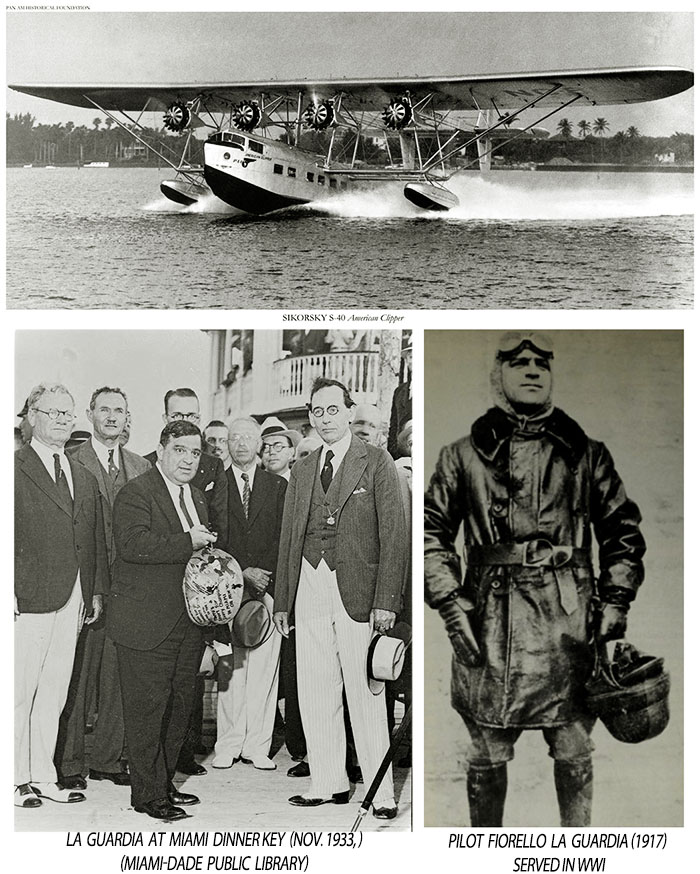
Photo Compilation: Pan Am Sikorsky S-40 American Clipper (PAHF Collection)/“Mayor of New York City, Fiorello La Guardia with Group at Dinner Key base,” ) Miami-Dade Public Library System, Gleason Romer collection. https://digitalcollections.mdpls.org/digital/collection/p17273coll3/id/12559/rec/1)/LaGuardia in pilot uniform (1917) (Public domain photo, Wikimedia).
Nov. 7, 1933, election results showed that Fiorello LaGuardia’s strategy of uniting disparate New York City constituencies had worked. The former US Army Major, Congressman, & pilot (often dubbed “the little flower” in New York) was now Mayor-elect of the largest city in the US. No stranger to aviation, he had been a pilot in WWI commanding a squadron of airplanes, later remaking a small airport in Queens into New York City’s first international airport.
Just 4 days after the grueling mayoral race, LaGuardia boarded the S.S. Philadelphia with his wife Marie & friends Aero Digest co-editors Frank & Jessica Tichenor bound for Panama. Thanks to “leaks,” when ship docked in Havana Nov. 14th, the hoped-for peaceful (& private) sea cruise was now public knowledge.“Little Flower” wanted to fly to Miami from Havana but no plane was available. So the LaGuardia party sailed off to Panama Canal Zone as scheduled, not giving up on the idea of a return “air cruise.” On Nov. 20th, the LaGuardias & Tichenors boarded PAA’s Commodore NC 670M at Cristobal, piloted by Roy Keeler, bound for Barranquilla, going 4 hours to the southeast by air.
After a stop & quick tour, they were off again, this time bound for Kingston Jamaica on PAA’s “American Clipper,” a 2-year-old Sikorsky S-40. Although their 550-mile flight north began in the rain, the weather cleared and Fiorello, “the flying mayor,” enjoyed his view from 500 feet.
Next morning at the Myrtle Bank Hotel, Mayor-elect LaGuardia joined the others for breakfast and the trip to Kingston Harbor for a flight to Miami, stopping at Cienfuegos & Havana.
Pan Am’s “houseboat” terminal at Dinner Key was awash with well-wishers & local dignitaries when the Clipper arrived at 4:30pm. Photographers & reporters were eager to get to the Mayor-elect and he didn’t disappoint, working the press and the crowd with the skill of a seasoned politician, followed by a dinner hosted at the “One Hundred Club,” a group of wealthy men with winter homes in the area.
LaGuardia left Miami the next morning from Pan American Field (36th St. Airport - today’s Miami International) on Eastern Air Transport’s Curtiss Condor service to D.C. and Newark, NJ. (Passengers could take the bus for an additional 75¢ to NYC proper). After the trip, news reports claimed New York’s new mayor was “more an aviation enthusiast than ever.”
Sources:
“LaGuardia Leaves on Voyage to Panama.” NYT (12 Nov. 1933), p. 1.
“LaGuardia Irked by News of Plans.” NYT (15 Nov. 1933), p. 3.
“LaGuardia to Fly Home; Due in Panama Today.” NYT (17 Nov, 1933), p. 1.
“LaGuardia Flies 1,000 Miles Over Caribbean From Panama to Jamaica on His Way Home.” NYT (21 Nov. 1933), p. 2.
“La Guardia Starts Flight to Miami.” The Miami News (Monday, 20 November 1933), p. 1.
“LaGuardia to Fly to Capital Today.” NYT (22 Nov. 1933), p. 6.
“PAA Through Kingston 1930-1934.” Author’s database.
Nov. 28, 1933
“A Picture Tells Many Stories”
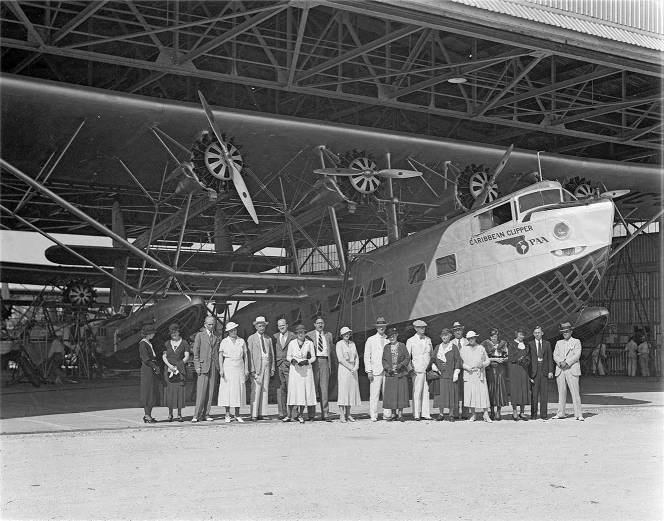
Gleason W. Romer, “Newspaper Group in front of Clipper at Dinner Key,”
Photograph, Miami-Dade Public Library https://digitalcollections.mdpls.org/digital/collection/p17273coll3/id/12577/rec/78
Nineteen nattily dressed guests – identified as “newspapermen” -- stood in the Thursday, November 23, 1933 sun outside Pan American Airways Dinner Key maintenance hanger #2 as photographer, Gleason Waite Romer, took two shots to record the group’s visit.
Their Thanksgiving Day outing included a tour of the seaport lead by Chief Tour Guide, Don “Doc” Singer, where the under-construction Art Deco terminal building had progressed beyond a steel-girder skeleton and better suggested its final look. The guests learned about Pan Am’s operations and had the opportunity to walk through it’s newest flying boat, the Sikorsky S-40, the first aircraft to carry the “Clipper” designation.
Any guest who turned away from Singer’s well-rehearsed spiel --
“Ladies and gentlemen! Here is the Caribbean Clipper, the largest commercial aircraft in the world. Forty passengers can be seated in the cabin which is wider by two feet than a regular Pullman railroad car. The ship is powered…”
-- and focused on the hanger’s interior, were presented material for a detailed feature story extolling the Pan Am’s “Safety First” culture.
Two flying boats, S-40 “Caribbean Clipper” NC81V and a Consolidated Commodore, were undergoing inter-flight inspection. Captain Ralph Dalhstrom had brought the “Caribbean Clipper” into Dinner Key on Tuesday evening the 14th after completing the three-day Miami-Barranquilla, Colombia via Havana, Cienfuegos and Kingston run.
Soon after, the Clipper had been trundled into Hangar #2 and the inspection process started. All external surfaces were inspected and the bottom paint removed to allow for hull resealing, all engines inspected and those needing overhaul removed and replaced. All propellers were pulled, inspected and resurfaced/polished, and all fuel and oil tanks drained, flushed, cleaned and inspected. Internally, the floor was removed and the bilge area cleaned to allow for hull inspection. Carpets, curtains and upholstery were cleaned, and all cargo areas emptied, cleaned and inspected for evidence of damage or presence of insects or contraband.
Now, nine days later, the Sikorsky S-40 neared Friday and Saturday post-inspection test flights. She would return to the Miami-Barranquilla run on Sunday, November 26 under the command of Captain Addison Person.
Sources:
“PAA Through Kingston 1930-1934.” Author’s database
Gleason W. Romer, “Newspaper Group in front of Clipper at Dinner Key,” Photograph, Miami-Dade Public Library. https://digitalcollections.mdpls.org/digital/collection/p17273coll3/id/12577/rec/78
Go back to "90 Years Ago" main page
